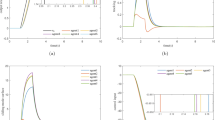Abstract
The problem of sate feedback control for discrete-time fuzzy systems with Takagi-Sugeno’s models is investigated to reduce the computational burden. A stabilization condition is obtained by applying a new Lyapunov function. It is shown that our new theorem is equivalent to an existing result in guaranteeing the stability of the fuzzy system but consumes less computational time than the latter. The effectiveness and the superiority of the proposed design approach are demonstrated by an example borrowed from the literature.
Similar content being viewed by others
References
Takagi T, Sugeno M. Fuzzy identification of systems and its applications to modeling and control. IEEE Trans Syst, Man, Cybern B, Cybern 1985, 15: 116–132
Sugeno M, Kang G T. Structure identification of fuzzy mode. Fuzzy Sets Syst, 1988, 28: 15–33
Tanaka K, Sugeno M. Stability analysis and design of fuzzy control system. Fuzzy Sets Syst, 1992, 45: 135–156
Tanaka K, Ikeda T, Wang H O. Robust stabilization of a class of uncertain nonlinear systems via fuzzy control: quadratic stability H ∞ control theory, and linear matrix inequalities. IEEE Trans Fuzzy Syst, 1996, 4: 1–13
Tanaka K, Kosaki T. Design of a stable fuzzy controller for an articulated vehicle. IEEE Trans Syst Man Cybern B, 1997, 27: 552–558
Tanaka K, Iwasaki M, Wang H O. Switching control of an R/C hovercraft: stabilization and smooth switching. IEEE Trans Syst Man Cybern B, 2001, 31: 853–863
Tanaka K, Ikeda T, Wang H O. Fuzzy regulators and fuzzy observers: relaxed stability conditions and LMI-based designs. IEEE Trans Fuzzy Syst, 1988, 6: 250–265
Yan S Y, Sun Z Q. Design and analysis of switching reduced-order observer and separation principle for T-S fuzzy system. Sci China Ser F-Inf Sci, 2009, 52: 1217–1232
Li H X. Probability representations of fuzzy systems. Sci China Ser F-Inf Sci, 2006, 49: 339–363
Tong S C, Li Y M. Robust adaptive fuzzy backstepping output feedback tracking control for nonlinear system with dynamic uncertainties. Sci China Inf Sci, 2010, 53: 307–324
Kim E, Lee H. New approaches to relaxed quadratic stability condition of fuzzy control systems. IEEE Trans Fuzzy Syst, 2000, 8: 523–534
Liu X D, Zhang Q L. New approaches to H ∞ controller designs based on fuzzy observers for T-S fuzzy systems via LMI. Automatica, 2003, 39: 1571–1582
Liu X D, Zhang Q L. Approaches to quadratic stability conditions and H ∞ control designs for T-S fuzzy systems. IEEE Trans Fuzzy Syst, 2003, 11: 830–839
Fang C H, Liu Y S, Kau S W, et al. A new LMI-Based approach to relaxed quadratic stabilization of T-S fuzzy control systems. IEEE Trans Fuzzy Syst, 2006, 14: 386–397
Feng G. state estimation of discrete time piecewise linear systems. IEEE Trans Signal Process, 2006, 54: 295–303
Dong J X, Yang G H. H controller synthesis via switched pdc scheme for discrete-time T-S fuzzy systems. IEEE Trans Fuzzy Syst, 2009, 17: 544–555
Zhou S S, Feng G, Lam J, et al. Robust H∞ control for discrete fuzzy systems via basis-dependent Lyapunov functions. Inf Sci, 2005, 174: 197–217
Wu H N. Robust H 2 fuzzy output feedback control for discrete-time nonlinear systems with parametric uncertainties. Int J Approx Reason, 2007, 46: 151–165
Sala A, Ariño C. Asymptotically necessary and sufficient conditions for stability and performance in fuzzy control: Applications of Polya’s theorem. Fuzzy Sets Syst, 2007, 158: 2671–2686
Guerra T M, Vermeiren L. LMI-based relaxed nonquadratic stabilization conditions for nonlinear systems in the Takagi-Sugeno’s form. Automatica, 2004, 40: 823–829
Ding B C, Sun H X, Yang P. Further studies on LMI-based relaxed stabilization conditions for nonlinear systems in Takagi-Sugeno’s form. Automatica, 2006, 42: 503–508
Wang L K, Liu X D. Comments on Further studies on LMI-Based relaxed stabilization conditions for nonlinear systems in Takagi-Sugeno’s form. Automatica, 2008, 44: 2992–2993
Author information
Authors and Affiliations
Corresponding author
Rights and permissions
About this article
Cite this article
Wang, L., Liu, X. Stabilization for discrete-time fuzzy systems with Takagi-Sugeno’s models: reduce the complexity. Sci. China Inf. Sci. 53, 2506–2513 (2010). https://doi.org/10.1007/s11432-010-4116-4
Received:
Accepted:
Published:
Issue Date:
DOI: https://doi.org/10.1007/s11432-010-4116-4




